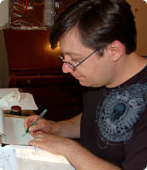The last post generated quite a few interesting questions, so I decided to push ahead with another round. As always, these are purely my opinions and may contradict canon material.
In general, how much is it worth correcting players who, during play, misremember aspects of a setting?
This depends on a number of different factors.
- Is the element directly important to the current adventure? Will the flawed recollection interfere with players’ ability to enjoy the story?
- How will your players respond to being corrected? Will it be a welcome clarification, or cause irritation?
- Is the misremembered element something that is especially important to you or your interpretation of Eberron? Is it something fundamental (the Last War was fought between the Five Nations, not between Galifar and Riedra) or a point of trivia that actual people in Eberron might not know (according to Faiths of Eberron, House Medani helped end the lycanthropic purge by creating a focus item that identified lycanthropes).
As someone who travels the world running Eberron games, I often have players who aren’t familiar with the setting. Perhaps I’ve got a player in a one-shot who is treating his warforged like a robot. I know that there’s lots of differences between warforged and robots. But his interpretation isn’t going to interfere with the one-shot adventure, and my explaining the differences will frustrate him rather than improve his enjoyment of things. On the other hand, if I had that same player in a campaign that was going to last for a year and involve interactions with other warforged, House Cannith, and the Lord of Blades, I probably would explain the differences so he’d have the proper context for his interactions with these forces. And if someone said “This ‘Last War’ was fought against the goblins, right?” I’d explain it right away.
Codex sounds very interesting. When will we be able to know more about it? I’d like to know if you’ll create it entirely on your own or if supporters will somehow participate, as happened with the Midgard campaign setting.
I will be writing a longer post about it sometime within the next week; I have a few deadlines I need to deal with first. I’ll address the design process in that post.
Concerning colonization… wasn’t Stormreach originally a colonial post of Galifar?
No. This is discussed in more detail in City of Stormreach. It was established as an outpost by pirates and legitimized by a compact with Galifar, but it was never subject to Galifar’s laws or authority, and it wasn’t settled according to any sort of royal plan.
Secondly, is there room for unknown continents in Eberron?
There’s room for anything in Eberron if you want to come up with a story for it. But a mystery continent is a big add, because Eberron has been well-explored. From dragons to gnomes to elves, you’ve had a host of intelligent, sophisticated races exploring the world. How did this continent go undiscovered? Was it hidden by magic? Has it just risen from the ocean floor? Or have people known about it but never gone there, and if so, why has that changed?
By contrast, Codex is set during a period of exploration, and the potential to discover new lands is one opportunity for people to add their own flavor to the setting.
Are there concepts or facets of Eberron that seem intrinsically influenced or tied to certain editions, such as 3E where it was debuted and 4E where it got its (arguably) first big makeover? As a DM I feel pretty confident in my ability to fit rules, story and player expectations into a package everyone will have fun with, but I’m curious if the issue’s ever come up with the mighty Hellcow.
Not big ones, but sure, there’s a lot of little things. A few examples:
- Eberron was originally designed for D&D 3E, but by the time it was released D&D was up to 3.5. The changes might seem fairly minor, but they can still have an impact. Notably, in 3E, any lycanthrope can spread the curse; if you’re bitten by a werewolf and turned, you can bite me and turn me. This was the impetus for the Lycanthropic Purge: lycanthropy is a dangerous contagious curse that could easily spread out of control if not contained. But 3.5 changed this so that only natural-born lycanthropes could spread the curse; a true werewolf could bite you and turn you, but you couldn’t pass it to me. This completely changes the exponential threat potential and makes the Purge seem like overkill. Hence we shifted the story to say that back in the time of the Purge, the curse was stronger and all ‘thropes were infectious; the Purge weakened it, so it’s no longer the threat it once was.
- The first Thorn of Breland novel was written during the 3.5 era. In 3.5, dragons possess blindsight, and this plays a role in the story. Likewise, Thorn is very much a 3.5 Assassin; if she gets a little while to watch you, she can do a sudden death strike, and she knows a handful of spells (disguise self, spider climb, etc). In 4E, dragons DON’T possess blindsight, and at the time of the second novel, there were no rules for assassins. I ended up simply ignoring most of these things… though I did address the Eladrin in the third Thorn novel.
Races would probably be the biggest change; with 4E, we wanted a place for the new core PHB races – dragonborn and eladrin. I feel we did a reasonably good job of fitting these in without dramatically changing the world, and I like the role of the Eladrin. But it did take some thought.
In general, Eberron was designed with 3E D&D in mind – but it can certainly be adapted to any system.
All this time I thought it was the Silver Flame Church who started the anti-Lycanthrope purge, not the Flame itself/Tira!
If you haven’t read it, I’d take a look at this Dragonshard article about the Purge. A lot of people have the wrong idea about the Purge, and think that the Keeper got up one day and said “You know what I feel like doing? Hunting down lycanthropes who are minding their own business.” In fact, the Purge began as a war of defense and containment after there was an exponential surge in lycanthropy in what is now the Eldeen Reaches. Waves of lycanthropes were raiding Aundair, and at that time the curse was highly contagious. I like to describe it as “28 Days Later with werewolves instead of zombies.” The first days of the “Purge” were much like the marines versus the xenomorphs in Aliens: brutal and terrifying. One to one, very few templars were a match for a lycanthrope, and one bite is all it takes to turn an ally into an enemy. After years of bloody conflict the tide turned in favor of the Silver Flame, but it was no easy battle. The decades of persecution that followed were fueled by a hunger for revenge, especially on the part of the Aundairians who had lost homes, friends, and family to the lycanthrope plague. This is why the Aundairian Pure Flame are the most zealous and aggressive followers of the Silver Flame; their branch of the faith was born in war and vengeance.
And lastly, it says in Faiths of Eberron that the Lycanthropic Purge ended shortly after House Medani invented a dragonshard focus that could detect lycanthropes. Do you have any thoughts on how this item would function?
I didn’t work on Faiths of Eberron, so I don’t know what the author had in mind. As a dragonshard focus item, it would require an heir of the house to operate it. Other than that, I’d have it function as best fits your story. It could be a tracker a la Aliens, which notes general position and distance, but not complete details; this would allow you to maintain some mystery. “There’s definitely a werewolf in this room… but which of us is it?” If you want to kill that mystery, it could be a monocle that reveals the lycanthrope’s true shape, but thus only works with line of sight.
It says in the Eberron Campaign Setting that “when mortals dream, they psychically project their minds to Dal Quor.” What about immortals? Could a bound rakshasa rajah in suspended animation find a way to project his mind to Dal Quor?
The basic idea is that mortal spirits are influenced by all of the planes, and pulled between them. We slip into Dal Quor when we dream. We’re pulled to Dolurrh when we die. Beyond this, we are creatures of body and soul; it’s the spirit that visits Dal Quor when you dream, leaving your body behind.
Meanwhile, immortals are physical embodiments of ideas. This has two aspects. First, the immortal doesn’t dream the way mortals do. Its body isn’t mere flesh: it’s a physical representation of its spirit. The two don’t separate. If it wants to go to Dal Quor, it goes there in one piece. So it doesn’t “dream”, but it could planar travel. This ties to the second point. The mortals of Eberron are touched by all planes. War and peace, light and darkness, madness and dream; all of these things shape mortal minds. An immortal is a creature of one shade. It is PURE war, unadulterated madness or dream. It is a physical embodiment of the core ideas of its plane. A rakshasa or a Fernian balor has no innate connection to Dal Quor; dreams aren’t part of their core identity.
Having said that, could a Khyberian Overlord find a way to project itself into Dal Quor? Sure. If that’s the story you want to have happen, make an explanation. Perhaps Bel Shalor’s connection to the Silver Flame lets it ride mortal spirits into Dal Quor. Perhaps the followers of the Voice In The Darkness have created an eldritch machine that lets her push into the realm of dreams. If you want it to happen, decide what it takes. But it’s not normal, and it would be a significant event.
Furthermore, it also states that “the only way to reach Dal Quor from the Material Plane is through the psychic projection of dreaming.” Does this mean that only mortals on the material plane dream? What about mortals on other planes? What about mortals from the material plane traveling to other planes?
As noted above, creatures of Eberron are inherently shaped by all of the planes, and it its this connection to Dal Quor that lets us go there when we dream. Many of the planes don’t HAVE mortal inhabitants… or their mortal inhabitants are immigrants (or descendants of immigrants) from the material plane. I would say that most native mortals don’t go to Dal Quor when they sleep; in this I’ll point to the Eladrin, who don’t dream. Do traveling mortals dream? I’d say it depends on the plane. In Fernia, you might dream in Dal Quor; however, planes such as Baator (well, demiplanes) or Dolurrh might have a spiritual gravity that prevents you from escaping through dreams.
Do some noble lords have their own armies, as in feudal societies?
Yes and no. If you look to Karrnath, while the army has a national command structure, individual forces are raised and maintained by the noble families; the leaders of each family are known as warlords. So while the army typically serves the coordinated vision of the king, every soldier is personally loyal to a specific warlord, and any warlord could choose to remove his support from the king – something Kaius has to keep in mind. While this has been specifically called out in Karrnath, I imagine it’s the basic model for most of the nations: nobles are charged to raise and maintain elements of the national armies. Beyond this, there’s nothing stopping nobles from having their own private forces. The only restriction that’s ever been mentioned is the Korth Edicts, which prevent Dragonmarked Houses from having armies. If a noble of Galifar wants an army and can afford to maintain it, that’s their business.






